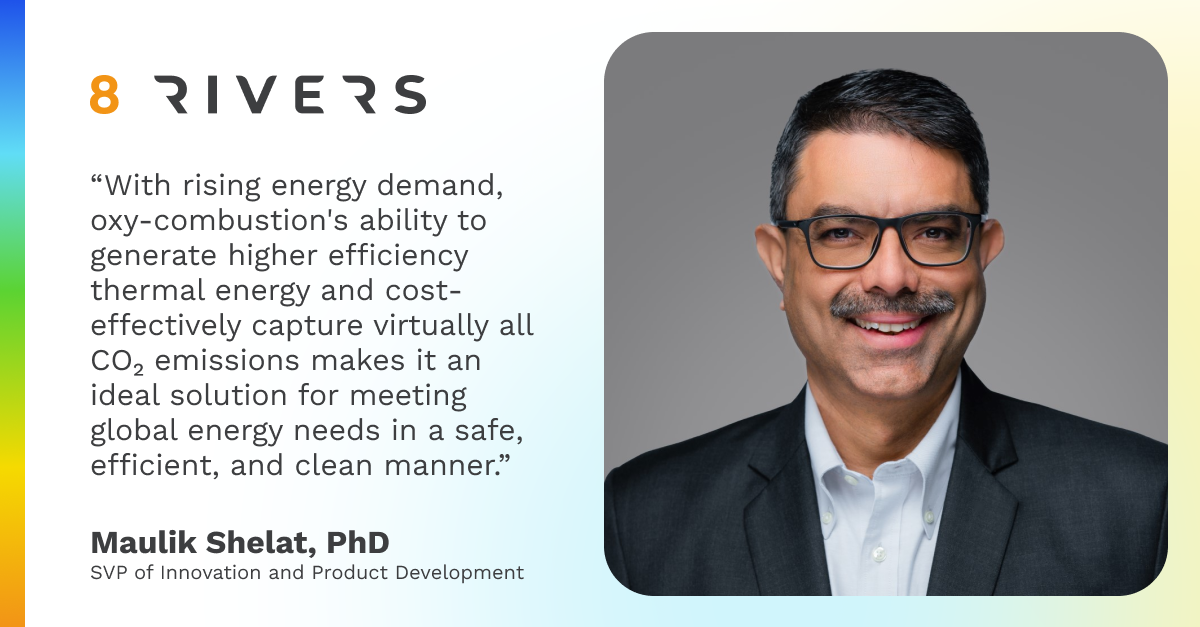8 Rivers’ SVP Maulik Shelat, PhD is an expert in industrial gases with years of experience in process design and technology development. In this Q&A, Dr. Shelat explains how oxy-combustion of hydrocarbons with inherent carbon capture harnesses pure oxygen to unlock efficient, cost-effective carbon capture, offering a scalable solution to decarbonize multiple industries.
What is oxy-combustion, and how does it work?
Flue gas produced by the combustion of carbon-containing fuels using ambient air has CO₂ concentration of only about 5-10%, making it uneconomical to separate CO₂. In simplest terms, oxy-combustion is burning fuel—typically carbon-based—in the presence of a synthetic oxidant prepared by mixing pure oxygen with recycled CO₂. During the oxy-combustion process, purified oxygen, which is sourced from an air separation unit (ASU), is introduced to a combustion chamber where fuel is burned to release energy, emitting a flue gas composed of CO₂ and water. Oxy-combustion of fuel results in less NOx formation and provides an opportunity to achieve higher combustion temperatures.
What types of systems and fuels can be used with oxy-combustion?
Oxy-combustion can use any carbon-based fuel such as natural gas, gasoline, diesel, biomass, municipal solid waste, coal, pet coke, and heavy distillates that otherwise would have been combusted with ambient air.
What makes oxy-combustion an exciting/unique process for clean energy production?
Flue gas from oxy-combustion is primarily CO₂ and water, drastically simplifying carbon capture without the need for solvent-based capture systems. This avoids the energy penalty, large footprint, and potential environmental and health concerns associated with solvents and their by-products.
By reimagining the problem as a solution, oxy-combustion with inherent carbon capture transforms CO₂ from a planet-warming waste stream into a profitable working fluid, providing inherent capture at a lower cost and higher capture rate than conventional technologies. Oxy-combustion enhances the commercial viability of decarbonization projects and, unlike competing technologies, produces pipeline-quality CO₂ without the burden of additional back-end capture equipment and processes.
Other decarbonization approaches, for example, capture post-combustion emissions through amine or other solvents, are expensive and significantly reduce the efficiency of the overall process. As another example, natural gas could be converted to hydrogen while capturing CO₂ and then this lower carbon intensity hydrogen could be fired with ambient air to remove CO₂ emissions. However, besides being expensive and suffering from the loss of efficiency in conversion to hydrogen, emissions like NOx continue to be released into the atmosphere.
Conventional hydrogen production technologies struggle to exceed the >95% carbon capture rate without significant cost and efficiency penalties. In contrast, hydrogen production methods using oxy-combustion deliver carbon capture rates of over 99% with 5-7% greater efficiency and 5-10% lower levelized cost of hydrogen (LCOH).
How is 8 Rivers deploying oxy-combustion?
Oxy-combustion creates a flexible platform for multiple clean energy applications. It allows for high-efficiency combustion, inherent CO₂ capture, and integration into diverse industrial and power generation settings.
Oxy-combustion is at the core of several 8 Rivers technologies. For example, the Allam-Fetvedt Cycle (AFC) is a supercritical CO₂ cycle that uses oxy-combustion of hydrocarbons, sending the CO₂ through a turbine as the working fluid in a semi-closed-loop system. The result is a power generation cycle with inherent CO₂ capture that does not emit harmful pollutants like NOx. Last year, 8 Rivers and Siemens Energy announced a partnership to develop and deploy a power generation turbine that generates electricity using supercritical CO₂ with > 99% CO₂ capture.
As another example, 8 Rivers’ Hydrogen process called 8RH2, utilizes oxy-combustion to produce hydrogen by combusting natural gas or other carbonaceous fuels to create a CO₂ working fluid that acts as the heat transfer medium in the CO₂ Convective Reformer. 8RH2 is set for its first commercial deployment at Cormorant Clean Energy in Port Arthur, Texas.
What are the biggest misconceptions about oxy-combustion?
The first would be that it’s too expensive. Historically, oxy-combustion wasn’t widely used because there was no incentive for capturing CO₂. That’s changed now. CO₂ is a valuable commodity on its own as both a raw material and for generating carbon credits. Another misconception is that ASUs are cost-prohibitive, but compared to other more expensive and less efficient carbon capture technologies, the value proposition for oxy-combustion and its necessary equipment and processes becomes more compelling.
What role could oxy-combustion play in achieving global net-zero goals?
Most energy projections predict an energy mix with significant amounts of carbon-based energy sources through 2050 and beyond. Oxy-combustion could help ensure that every new fossil-fuel asset that comes online is net zero.
Ultra-low-carbon hydrogen, which can be efficiently produced using heat from oxy-combustion via technologies like 8RH2, could help decarbonize heavy industries and hard-to-abate sectors, such as shipping, heavy-duty transportation, and cement and steel production. Hydrogen holds promise as a low-carbon export fuel to help countries with limited resources and space reduce emissions while boosting energy security.
Low-carbon and 24×7 baseload power can be generated through AFC, a supercritical CO₂ cycle that utilizes oxy-combustion of hydrocarbons, sending the CO₂ through a turbine as the working fluid in a semi-closed-loop system. A synergy of complementary processes, like AFC for power generation and 8RH2 for hydrogen, could result in lower emissions at reduced costs compared to conventional technologies, while achieving emissions levels similar to many renewable technologies at lower costs and with greater scalability.
Oxy-combustion is a cost-effective method for capturing point-source emissions while delivering pipeline-quality CO₂ without the need for post-combustion capture. When deployed within power generation and fuel production platforms, it is a promising solution that can help nations and organizations meet decarbonization goals without compromising on affordability and reliability.
Why is now the right time for companies and governments to adopt oxy-combustion technology?
With the rising demand for decarbonized energy at scale, oxy-combustion’s ability to generate higher efficiency thermal energy and cost-effectively capture virtually all CO₂ emissions makes it an ideal solution for meeting global energy needs in a safe, efficient, and clean manner. It offers a highly scalable, cost-effective solution to decarbonize multiple industries, including power, steel, cement, and heavy-duty transportation, thereby enabling both energy security and decarbonization.
